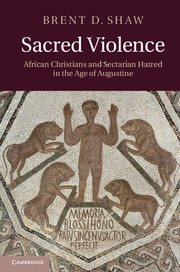Book contents
- Frontmatter
- Contents
- Abbreviations
- Maps
- Acknowledgments
- Introduction
- Chapter 1 This terrible custom
- Chapter 2 Church of the traitors
- Chapter 3 A poisonous brood of vipers
- Chapter 4 Archives of memory
- Chapter 5 The city of denial
- Chapter 6 Ravens feeding on death
- Chapter 7 Little foxes, evil women
- Chapter 8 Guardians of the people
- Chapter 9 In the house of discipline
- Chapter 10 Sing a new song
- Chapter 11 Kings of this world
- Chapter 12 We choose to stand
- Chapter 13 Athletes of death
- Chapter 14 Bad boys
- Chapter 15 Men of blood
- Chapter 16 Divine winds
- Chapter 17 So what?
- Appendix A Bishops and bishoprics in Africa: the numbers
- Appendix B Origins of the division: chronology
- Appendix C The Catholic conference of 348
- Appendix D The Edict of Unity and the Persecution of 347
- Appendix E The mission of Paul and Macarius
- Appendix F Historical fictions: interpreting the circumcellions
- Appendix G The archaeology of suicide
- Appendix H African sermons
- Bibliography
- Index
- References
Chapter 15 - Men of blood
Published online by Cambridge University Press: 07 September 2011
- Frontmatter
- Contents
- Abbreviations
- Maps
- Acknowledgments
- Introduction
- Chapter 1 This terrible custom
- Chapter 2 Church of the traitors
- Chapter 3 A poisonous brood of vipers
- Chapter 4 Archives of memory
- Chapter 5 The city of denial
- Chapter 6 Ravens feeding on death
- Chapter 7 Little foxes, evil women
- Chapter 8 Guardians of the people
- Chapter 9 In the house of discipline
- Chapter 10 Sing a new song
- Chapter 11 Kings of this world
- Chapter 12 We choose to stand
- Chapter 13 Athletes of death
- Chapter 14 Bad boys
- Chapter 15 Men of blood
- Chapter 16 Divine winds
- Chapter 17 So what?
- Appendix A Bishops and bishoprics in Africa: the numbers
- Appendix B Origins of the division: chronology
- Appendix C The Catholic conference of 348
- Appendix D The Edict of Unity and the Persecution of 347
- Appendix E The mission of Paul and Macarius
- Appendix F Historical fictions: interpreting the circumcellions
- Appendix G The archaeology of suicide
- Appendix H African sermons
- Bibliography
- Index
- References
Summary
And I will execute great vengeance upon them with furious rebukes; and they shall know that I am the Lord, when I shall lay My vengeance upon them.
(Ezekiel)Just how violent were the sectarian circumcellions? How eager were they, in the much-quoted biblical parlance of the time, to rush with their feet to shed blood? In the context of the types of violence that characterized late Roman Africa, the episodes of circumcellion violence did not amount to anything much above the level of hard street-fighting – the mayhem of fisticuffs, stabbings, beatings, and the occasional homicide ordinarily indulged in by gangs of harvester workers. Their violence was not remotely close to a war, to “barbarian incursions” – even where these latter were smaller interpellations of wandering bands – or, much less, to the systematic violence of slavers whose attentions in these years were turning more intently to exploit the “inside supply” offered by vulnerable rural peoples in Africa. Nor was circumcellion violence comparable to the large regional upheavals of the kind that involved a Firmus or a Gildo. In terms of scale, their destructiveness was at the distal end of a grid of violence, close to individual acts of physical aggression. A standard list of acts of sectarian violence in Africa of the period includes assaults on basilicas, the forced ritual cleansing of sacred sites, sacrileges committed against holy objects, injuries inflicted on persons and attempts on the lives of clergy. What was the place of circumcellion actions in these and similar actions? Rather than rushing to exaggerated claims about rural jacqueries or social rebellions, questions need to be posed first about the modes and styles of circumcellion violence and about the specifics of their targeting practices. Most circumcellion violence, by far, was rural in nature, taking place in small towns, rural villages, and in the full countryside around market centers or on farms. Their violence was the opposite of the “pagan”–Christian riots that were mainly urban in nature.
The social and work background out of which these men emerged has been mostly imputed and generally misunderstood. A fairly standard picture of the behavior of itinerant seasonal labor gangs out of whose ranks the sectarian circumcellions were recruited is one of men who always had a potential for violence. Migrant mobility, the lack of local family attachments, the dynamics of young men in groups, the physical nature of the work – all of these factors, and others, conduced to occasional outbreaks of violence. Beyond and behind these specific links was the fact that young men were always a problem. When added to the pressures and inducements of work on the road, the catalyst of alcohol encouraged violence inside and between itinerant harvesting gangs, and between them and local communities. Whether or not violence erupted on any specific occasion or harvest season, locals were nevertheless apprehensive, and they were prepared for the worst. But the reaping gangs on the move were not the only armed men associated with the harvest who were capable of violence or prone to it.
- Type
- Chapter
- Information
- Sacred ViolenceAfrican Christians and Sectarian Hatred in the Age of Augustine, pp. 675 - 720Publisher: Cambridge University PressPrint publication year: 2011

